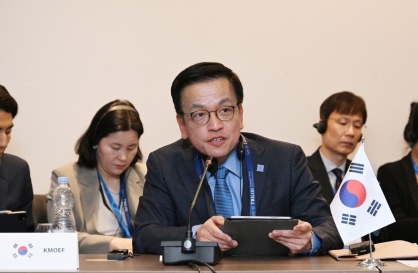Officials in Jeju are busily sprucing up the island for a major gathering of environmental experts in the fall, hoping to seize the opportunity to put it on the global eco-tourism map.
The volcanic island off the southern coast is a designated World Natural Heritage Site and home to a Biosphere Reserve, Ramsar Wetland, Global Geopark and much more.
Those attractions will be on display when more than 10,000 policymakers, activists and scholars in the environmental field gather for the 2012 IUCN World Conservation Congress at International Convention Center Jeju Sept 6-15 under the theme of “Resilient Nature.”
The volcanic island off the southern coast is a designated World Natural Heritage Site and home to a Biosphere Reserve, Ramsar Wetland, Global Geopark and much more.
Those attractions will be on display when more than 10,000 policymakers, activists and scholars in the environmental field gather for the 2012 IUCN World Conservation Congress at International Convention Center Jeju Sept 6-15 under the theme of “Resilient Nature.”

On the sidelines of intensive debates and discussions, the participants will have a chance to explore the host island as part of the official excursion program on Sept. 13.
A total of 51 tour courses are on offer for the one-day program taking as many as 5,000 of the participants to its lush forests, mountains, beaches and villages.
“We’ve selected 51 walking trails for participants of the World Conservation Congress and are now in the process of refurbishing them for international visitors,” said Ko Hyoung-jong, an official at Jeju provincial government.
About 19.1 billion won ($16 million) has been set aside for the eco trails, from the development of routes to erection of English signboards, he explained.
The 51 courses can be divided into three ― the first group is to explore Jeju’s natural beauty and its world-renowned environmental assets, another focusing on its historical and cultural side and finally some programs aimed at introducing the island’s efforts to go green.
Some of the trekking courses take participants to “oreum,” or parasitic volcanic cones that are spread throughout the island.
Geomun Oreum is one of the must-sees for eco tourists, designated an UNESCO World Natural Heritage site and Korea’s Natural Monument No. 444. Literally meaning “dark and blackish oreum,” the area emits an eerie and mystical force emanating from the thickly wooded forest inside the crater.
Another World Natural Heritage site and one of the most scenic landmarks of Jeju is Seongsan Ilchulbong, or Sunrise Peak. It is a rare site even among numerous craters on the volcanic island, having formed from the eruption of an undersea volcano some 100,000 years ago. Locals often frequent it to enjoy a magnificent sunrise.
By Lee Sun-young (milaya@heraldcorp.com)
-
Articles by Korea Herald





![[Weekender] Korean psyche untangled: Musok](http://res.heraldm.com/phpwas/restmb_idxmake.php?idx=644&simg=/content/image/2024/05/02/20240502050841_0.jpg&u=)


![[Eye Interview] 'If you live to 100, you might as well be happy,' says 88-year-old bestselling essayist](http://res.heraldm.com/phpwas/restmb_idxmake.php?idx=644&simg=/content/image/2024/05/03/20240503050674_0.jpg&u=)









![[Herald Interview] Director of 'Goodbye Earth' aimed to ask how we would face apocalypse](http://res.heraldm.com/phpwas/restmb_idxmake.php?idx=652&simg=/content/image/2024/05/03/20240503050732_0.jpg&u=)
